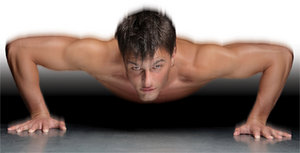According to Dr. Larry Leigh, assistant professor at the University of Windsor, "Initial research was primarily focused on sports performance, but now there's a considerable shift toward (whole-body vibration) applications as a therapeutic tool. Outcomes such as increased strength, flexibility, circulation and pain reduction are now being focused on for such conditions as arthritis, back pain, osteoporosis, multiple sclerosis and the geriatric population."
How Will It Benefit You? Now that you have a good understanding of how vibration therapy and exercise work, the more important question is, how will it benefit you? Being able to have your muscles work at such a fast pace has many health and fitness benefits - here are just a few:
Positive effects on strength: There are really two ways to get stronger. One way is depicted in magazines and movies all the time. The media has shown us that the only way to get stronger is to get bigger muscles by lifting heavy weights. However, there is another way to get stronger. We don't use all of our muscles when we lift something or move. Therefore, the more muscles you use, the more you are able to lift or carry. Vibration exercise, because it is involuntary, helps you use more of your muscles. When you use more muscles, you are able to do more. It's that simple. This is especially important for the elderly, who often require good strength to be able to stay independent.
Positive effects on circulation: Gentle, rapid contractions allow the muscle to work as a pump, resulting in increased blood flow within the circulatory system. This allows the body to carry off waste products much faster, thereby enhancing circulation and recovery. This is very important for people with diabetes, for whom poor circulation is a serious consequence of their condition.
Positive effects on bone: Vibration therapy/exercise has a positive effect on bone. This is based upon Wolffe's law, which states that bone responds to the physical stresses put on it. Rapid muscular contractions with vibration will lead to increased strength and favorable stresses being placed on the bone.
 Dr. Karl Johnson, a chiropractor and clinical nutritionist from Michigan, has found considerable success with vibration therapy. One of his first patients to use this modality was a 51-year-old female diagnosed with osteoporosis. The patient decided not to take medication and wanted another solution. After four months of vibration exercise therapy, her medical doctor's before-and-after bone density tests showed a 1.9 percent increase in bone mass, and the original osteoporosis diagnosis was downgraded to osteopenia.
Dr. Karl Johnson, a chiropractor and clinical nutritionist from Michigan, has found considerable success with vibration therapy. One of his first patients to use this modality was a 51-year-old female diagnosed with osteoporosis. The patient decided not to take medication and wanted another solution. After four months of vibration exercise therapy, her medical doctor's before-and-after bone density tests showed a 1.9 percent increase in bone mass, and the original osteoporosis diagnosis was downgraded to osteopenia.
"Vibration exercise has allowed me to treat the whole person," said Dr. Johnson. "We all know that intense weight training has a positive effect on bone density, but most patients may not be able to or are unwilling to do it. Vibration exercise only takes 15 minutes, three times per week, and has allowed me to provide comparable exercise effects to my patients."
Less stress on joints: When we think of getting stronger, we always picture adding more and more weight to our bodies and then going through the exercise motions. However, what if you're limited by pain? With vibration therapy and exercise, because you are using only your own body weight, maximum joint comfort is produced.
Vibration therapy and exercise are rapidly gaining momentum as useful tools by health professionals, including chiropractors, to provide exercise benefits for patients who may otherwise be unable to do regular training, or who simply want faster results than can be achieved through conventional exercise. Because vibration exercise allows you to contract your muscles involuntarily, a large amount of contractions can occur in a short period of time, putting less stress on your joints and allowing you to get the same exercise effects in 15 to 20 minutes compared to one hour at the gym. With all the health and fitness benefits it provides, more and more people will be using it to get the benefits they want. Ask your doctor about vibration exercise and how it can help you.
Jasper Sidhu, DC, graduated from Canadian Memorial Chiropractic College in 1994 and opened the Downtown Injury Rehab Centre in Windsor, Ontario, incorporating vibration training into the rehabilitation part of his practice. He is vice president of clinical services for WAVE Manufacturing (www.wavexercise.com).

